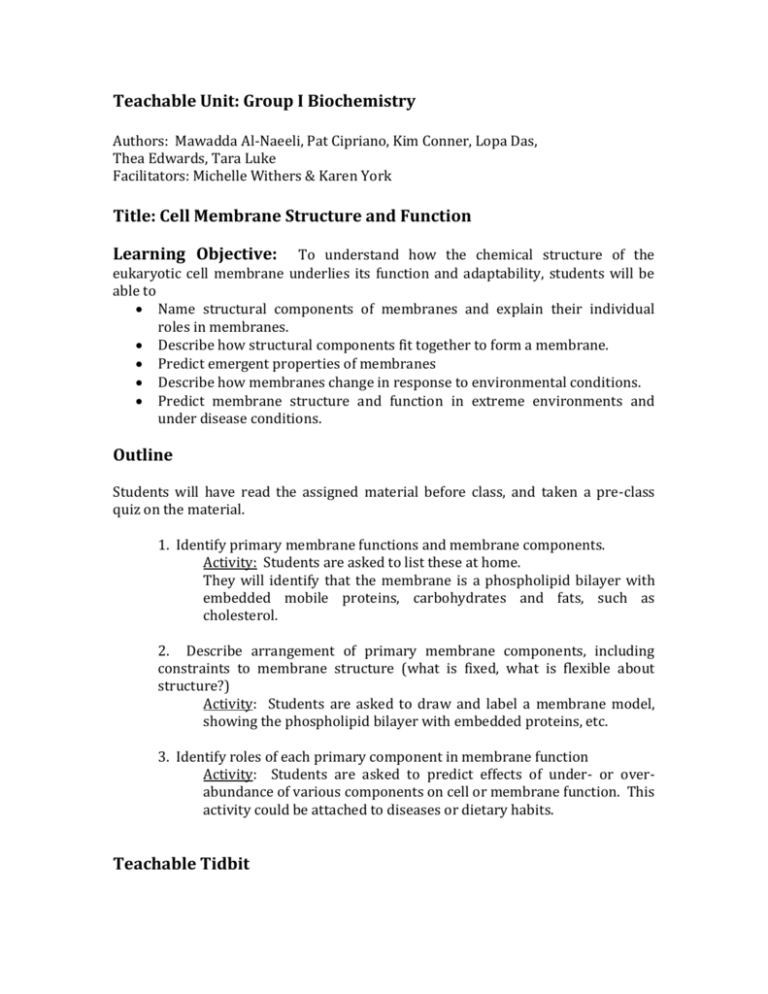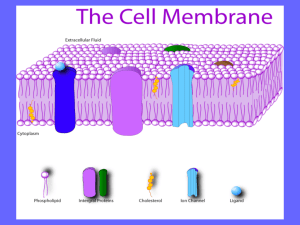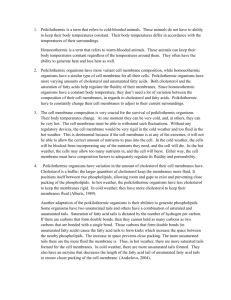Cell Membrane and Structure (framework) WVU 2013
advertisement

Teachable Unit: Group I Biochemistry Authors: Mawadda Al-Naeeli, Pat Cipriano, Kim Conner, Lopa Das, Thea Edwards, Tara Luke Facilitators: Michelle Withers & Karen York Title: Cell Membrane Structure and Function Learning Objective: To understand how the chemical structure of the eukaryotic cell membrane underlies its function and adaptability, students will be able to Name structural components of membranes and explain their individual roles in membranes. Describe how structural components fit together to form a membrane. Predict emergent properties of membranes Describe how membranes change in response to environmental conditions. Predict membrane structure and function in extreme environments and under disease conditions. Outline Students will have read the assigned material before class, and taken a pre-class quiz on the material. 1. Identify primary membrane functions and membrane components. Activity: Students are asked to list these at home. They will identify that the membrane is a phospholipid bilayer with embedded mobile proteins, carbohydrates and fats, such as cholesterol. 2. Describe arrangement of primary membrane components, including constraints to membrane structure (what is fixed, what is flexible about structure?) Activity: Students are asked to draw and label a membrane model, showing the phospholipid bilayer with embedded proteins, etc. 3. Identify roles of each primary component in membrane function Activity: Students are asked to predict effects of under- or overabundance of various components on cell or membrane function. This activity could be attached to diseases or dietary habits. Teachable Tidbit 4. Discover membranes as fluid/dynamic structures. At the end of this tidbit, students will be able to • predict how fluidity is determined by lipid components of the membrane, • predict how the lipid composition changes to maintain fluidity in extreme environments (tropical versus arctic), • practice drawing, reading, and interpreting graphs, • apply the concept of fluidity of a cell membrane to disease. Sequence of activities: Hook: Use the claims of positive health benefits of Omega-3 fatty acids to introduce the topic of membrane lipids. Discuss the fluid nature of membranes with an example of an experiment that helped elucidate this (video of how a cell recovers from photo-bleaching fluorescently tagged proteins embedded in its plasma membrane). Describe some of the factors that contribute to rigidity/fluidity within membranes, including type of fatty acid (unsaturated/saturated) and additional molecules (such as cholesterol). Clicker question concerning temperature and membrane fluidity. Activity concerning cholesterol and unsaturated and saturated fatty acids in cell membranes and their relationship to temperature. Activity involving the graphing of the “data” that were developed from the previous activity. This will allow students to demonstrate understanding of the scientific principles being discussed, while providing practice and experience with constructing a graph as a means of presenting data. Compare hypothetical dataset developed in the previous activity to published graph that illustrates cholesterol content in copepods found at different temperatures to reinforce the trend, and provide additional practice in interpreting a graph. Administer a summative assessment question involving subsets of variables. Students will be able to demonstrate their understanding of the effects of both temperature and lipid content on the fluidity of cell membranes. This question has multiple variables that can be substituted to adapt it to in-class discussions, homework, and exams. Tie this material back to human health by giving an example of human pathology associated with disease or dietary choices that cause changes in cell membranes. Assessment: Both formative and summative assessments are addressed in this unit. Formative assessment is in the form of clicker questions and teamwork that demonstrate knowledge or misconceptions about each individual component. Summative assessment is in the form of multipart adaptable questions that can be administered to groups in class, and included in a different form on a written exam.









